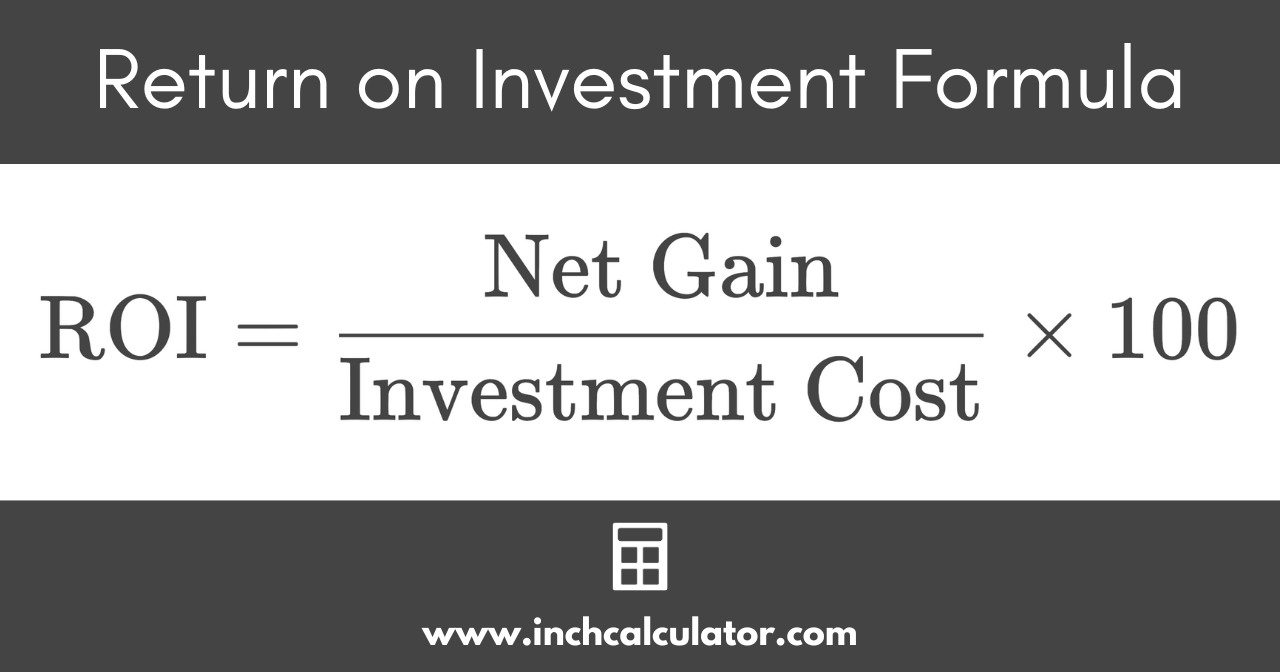ROI Calculator
Use our ROI calculator to calculate your return on investment, annualized ROI, and the gain or loss on the investment.
Return on Investment:
| ROI: | 100%
|
| Annualized ROI: | 14.87%
|
| Investment Gain: | $1,000.00
|
On this page:
How to Calculate Return on Investment
Return on investment (ROI) is a measure of profitability. ROI calculates the amount of profit earned on an investment over a period of potentially many years.
There are two formulas related to the return on investment. The first calculates the total return of the investment, and the second ROI formula takes the total return and annualizes it.
ROI Formula
The formula to calculate return on investment is:
where:
IV = cost of the initial investment
FV = final value of the investment, or the amount returned
Thus, ROI is equal to the final value minus the initial cost, divided by the initial cost, multiplied by 100%. Put another way, ROI is equal to the net gain of the investment divided by the cost, multiplied by 100%.

This formula calculates the total return of the investment. It does not annualize the return, but instead calculates the return over the life of the investment.
For example, imagine you made a $15,000 total investment in a handful of stocks. After 10 years, the investment grew to $45,000. Assume you added nothing to this investment. What would the ROI be?
Now let’s look at a real example with Apple (ticker AAPL). Apple finished 2015 trading at $24.16 and finished 2021 trading at $177.08. If you had invested in Apple at the end of 2015 and held it for 6 years, what would the return on investment be?
You can enter both of these scenarios into the calculator above to confirm. Test it out for other investments you follow to see how they have performed over a specific time period.
A few other similar profitability calculators you may be interested in are our return on equity calculator and margin calculator.
How to Calculate Annualized ROI
The second ROI formula calculates the annualized return on investment. This formula takes the ROI that was calculated earlier and converts it to an annual percentage, which makes it easier for investors to compare results to one another.
For example, if Investment A had an ROI of 200% after 6 years and Investment B had an ROI of 150% after 4 years, how do we know which one performed better? It could be that Investment A only has a higher ROI because it has two extra years of returns, or it could be that it outperformed Investment B.
The annualized ROI partially solves this problem, which is shown below.
Annualized Return on Investment Formula
The annualized ROI formula is shown here:
where:
ROI = return on investment
n = length of investment in years
Let”s go back to our two previous examples where we calculated the total ROI and now calculate the annualized ROI.
In our first example, we had a total ROI of 200% after 10 years. Note that 200% can also be written as 2.
Our second example was Apple’s ROI of 632.9% after 6 years. We will see that it had an annualized ROI of 39.37%.
You can also find these results using our rate of return calculator. This calculator won’t compute the total ROI, but it will give the annualized ROI.
Now we have a more informed answer to which investment performed better based on the annualized ROI calculation: the 200% ROI after 6 years (Investment A) or the 150% ROI after 4 years (Investment B). We can make the calculation simple.
For the 200% ROI, the initial value can be $1 and the final value can be $3. For the 150% ROI, the initial value can be $1 and the final value can be $2.50.
By entering these amounts into the calculator above, we see that the annualized ROI for Investment A was 20.09% and the annualized ROI for Investment B was 25.74%. Investment B had a higher annualized ROI even though it had a lower total ROI.
But this doesn’t mean for sure that Investment B outperformed Investment A. It could be that stock market returns in the first few years were poor. Therefore, Investment A had to endure these tough times while Investment B didn’t. Further research would be needed to see which one really was the winner.
Frequently Asked Questions
What is a good return on investment?
A good return on investment is entirely up to an investor’s risk appetite and time horizon. The stock market has historically averaged in the ballpark of 10% per year, and bonds have historically averaged under 6% annually.
If a stock investor is risky, then a good ROI for them will need to be greater than 10%. They will need to be compensated for taking on risk above and beyond the stock market as a whole.
However, a stock investor in who is more risk averse may be happy with a growth rate slightly under 10% because they will experience less risk in their portfolio.
Additionally, someone who has a long time horizon may want to have higher returns and risk compared to someone with a shorter time horizon.
A good growth rate is also one that beats a comparable benchmark. A high-risk technology investor will want to have a portfolio that consistently beats the NASDAQ, but an investor in safer value stocks will want to outperform the DJI.
This allows the investor to know if they are experiencing good growth relative to the amount of risk they are taking.
For example, Apple had an annualized ROI of nearly 40% from 2015 to 2021. Over this same time period, the S&P 500 (a comparable benchmark for Apple) increased from $2,043.94 to $4,766.18. If we plug these figures into the ROI Calculator, we get an annualized ROI of 15.16%.
Compared to the stock market’s historical annualized return of 10%, this is a period of high growth. But it doesn’t compare to Apple’s growth, so we can conclude that Apple had a good return on investment over this time.
Any stock in the S&P 500 that had an annualized ROI of less than 15.16% would be seen as an investment that underperformed its benchmark.
Does ROI mean profit?
ROI is the net gain, or net profit of an investment divided by the total cost of the investment. The term “profit” could be referred to as the profit in dollars, the rate of return, or the gross profit which does not take into account costs or expenses.
Why is ROI so important?
ROI is important because it helps investors determine how profitable their investment has been over time. It also allows investors and businesses to make future decisions based on historical ROI of their investments and is an important benchmark in determining their future investment strategies.
Is higher ROI always better?
If all other factors of two investments are equal, a higher ROI is better. However, a higher ROI generally indicates that it will take longer for an investor to receive their money back and a lower ROI generally indicates that an investor will receive their money back quicker.
Investors will typically want to balance their portfolio with a mix of both higher and lower ROIs, as long as they are positive.


